|




| |
Julia
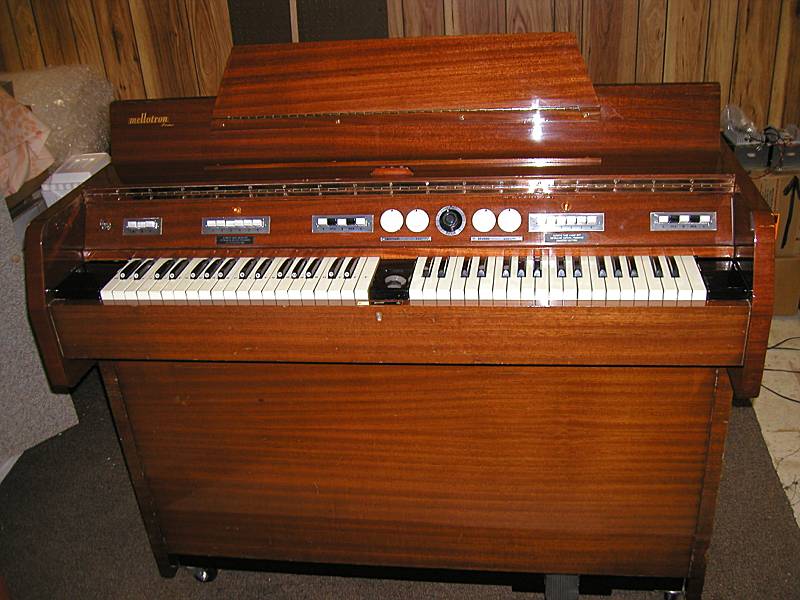
Mark I #124 was in most capable hands when Mellotron Professor Jerry Korb
decided to take on the restoration project. It is rumored that #124 spent
much of its life on a boat, and Jerry did find evidence of that. On either
side of the cabinet are screw holes, meaning the machine was likely tied to
something--necessary on a boat. Also the bottom of the cabinet had water
damage and there were salt crystals throughout. So it would seem that,
yep, this was the seaworthy 'tron.
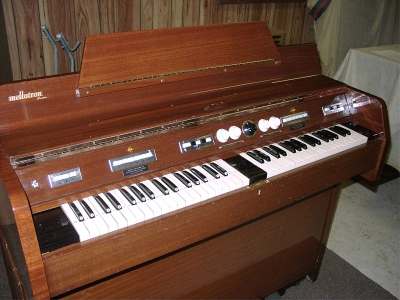 |
Jerry restored the bulk of the cabinet, including somehow getting around
the stubborn flow coat finish. He also replaced the mahogany veneer
bands along each edge. Notice that the bands run horizontally, easier
to bend but easier to split. No problem, Jerry's got that down. Of
course all the innards are fully restored, including an original Mark I
power pack, original style back cloth and speaker grille cloth (still
available from the original supplier), old Wharfedales, and original preamp.
About the only updates were to the amps (Jerry's design/build) and the
reverb section (Accutronics, as in the Mark II and Hammonds).
And it has original Mark II tape sets, with all their quirkiness! |
INSIDE...
| This was a complete restoration: cabinet; electronics; machanicals.
Basically every nut and bolt was removed, polished, and reinstalled, along
with every other part. In Frank Samagaio's The Mellotron Book
there is a picture of Julia's frame being lifted out of the cabinet on an
engine hoist.
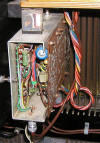
SSCU - Station Select Control Unit |
 |
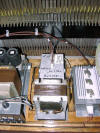 |
This is the original VFO speed control from King Crimson's "Crimson
King" Mellotron (Mark II #113), authenticity verified. It has found
its way into Julia and takes a little while to warm up, but it works
nicely, including being able to produce the lovely pitch swoops as used by
Mike Pinder in tracks like "The Voyage". |
 |
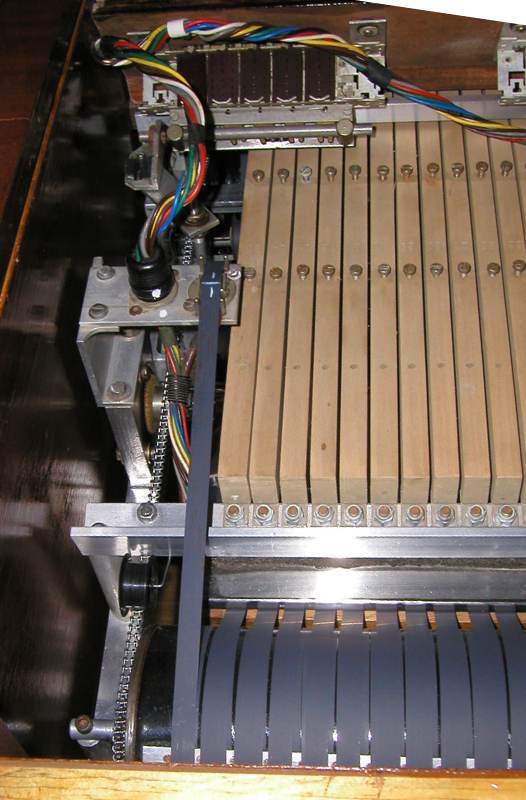 |
LEFT: The right hand side station changing mechanism. On the
left you can easily see the Meccano chain. Moving to the right is the
pulse tape, on which you can see labeled the pulse mark for Station 1.
At the bottom of the photo is the tape drum, and up top is the right-hand
(lead) track selector.
The tan things with the screws are the keys. Station selection works with
the pulse tape and the apparatus in the below photo. When you select a
station, the tape drums turn quickly as the arm below wipes over to the next
copper dot. Then the tape drum mechanism creeps until the tape pulse
mark is reached.
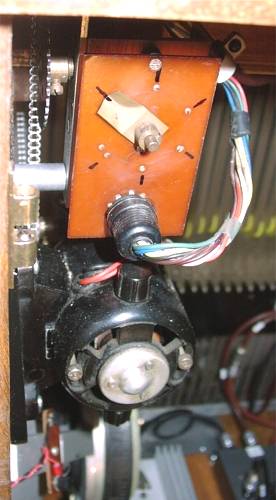
|
Astonishingly, Jerry has Julia tuned to where station changing takes but a
few seconds. On Station 1 there isn't even any creeping, as the pulse tape
mark is right there at the same time the wiper assembly hits the copper dot for
Station 1.

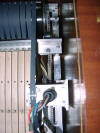 |
Signs of a Mellotron Mark I Jerry has the only Mark I in
the United States. This machine was never refitted with Mark II
enhancements, unlike all but about two or three of the original Mark I
machines. One of the differences is the bar that prevents you
from pressing down any keyboard keys while the tapes are cycling
between stations.
The Mark II also lost the Meccano chain in favor of a heavier
chain. However Jerry was able to find a suitable Meccano
replacement that is far stronger than the original chain and not prone
to twisting and breaking. Julia cycles flawlessly! Jerry
tells how he was able to obtain the more reliable Meccano chain:
The Meccano Collector's Club/Organization
provided me with the contact info to order this newer, stronger chain.
They also recently wrote a lengthy article about Meccano/Mellotron in
their recent newsletter. Special thanks to Mr. Lou Boselli of
Cornwall-On-Hudson, NY, without whom the entire Julia project would
not have been completed. Lou had the chain made to his
specifications. |
|
HOW DOES JULIA PLAY & SOUND?
Julia plays like a Mark II, which blows away almost any M400 on the planet
(there is one that I played somewhere that approaches the Mark II---I forget
which M400 that is, but others agreed there was something about that particular
machine). The Mark I/II series Mellotrons are quite easy to play, and they
are not plagued by wobblies or pressure pad dropouts as much as the M400s.
Why? The M400 keyboards contain all the parts, where in the Mark I/II the
keyboards basically contain the keys and pinch rollers. All other items
are securely tied into the machine. Somehow this design proves to be more
reliable when it comes time to play the Mark I/II Mellotrons.
 |
SEE IT -- HEAR IT
Professor Korb plays the MK6 and Julia.
Microsoft Windows Media clip, 986KB download |
Julia's preamp...
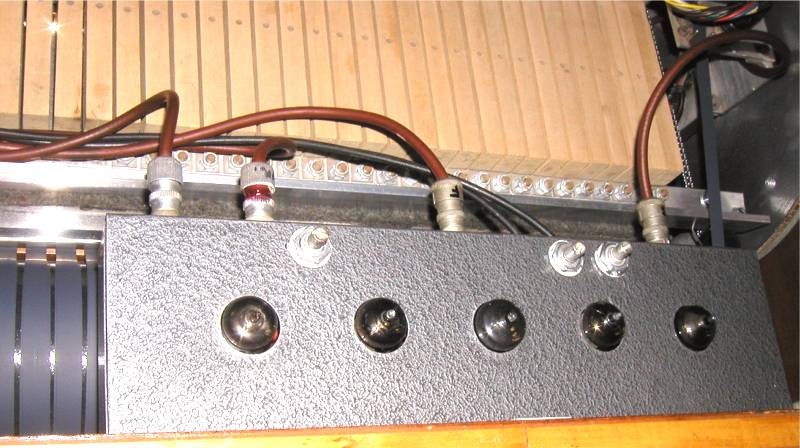
...was given the same treatment as everything else. This is a tube (or
valve) preamp (those knobby things poking out from the lid), original to the machine. Jerry
gave the preamp a new coating of Hammerite, the original paint used (and still
available). Hammerite, a tough, durable, and waterproof paint, was used to paint all kinds of stuff
for the British Navy. It was used to paint most electronic assemblies on
all Mellotrons, Mark I through the Mark V.
Julia's original reverb unit was nothing more than Mellotron tape springs and
phono cartridges---I kid you not!
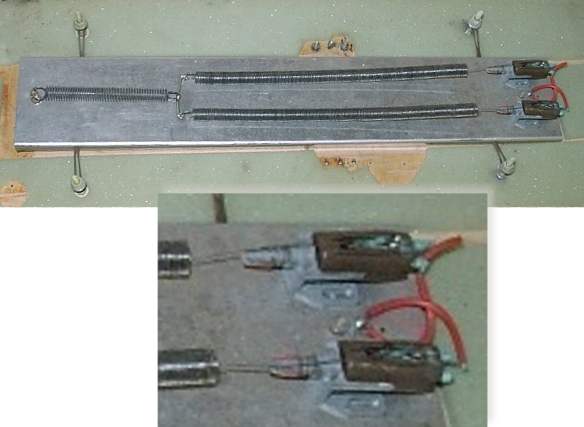
This unit has been replaced with
Accutronics 6-spring reverbs, the good stuff. Additionally the reverb
driver has been rebuilt. The reverb tank is in its original location at
the very bottom of the cabinet in its own compartment hidden away.
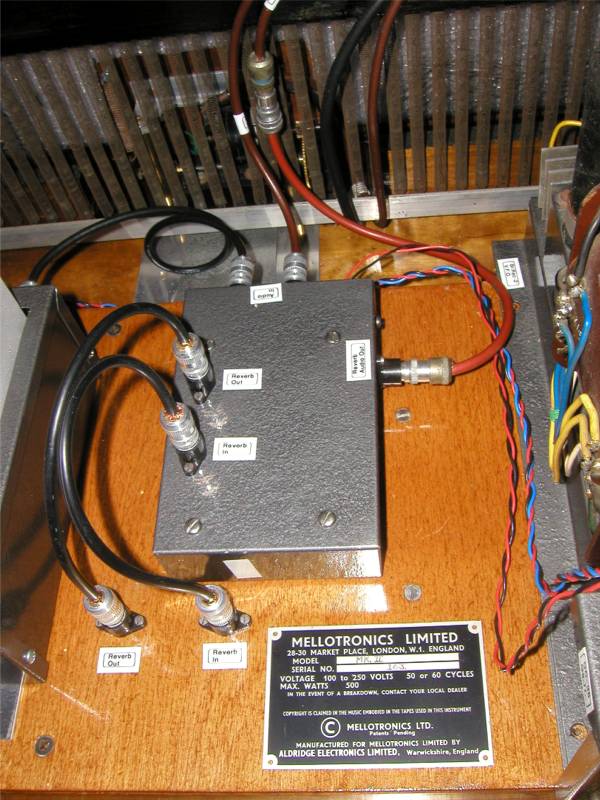
New reverb driver. Notice the use of the original hardware connecting the
audio cables.
FINISHING TOUCHES...
The original speaker grille cloth and back cover cloth is
available, and jerry replaced these as well.
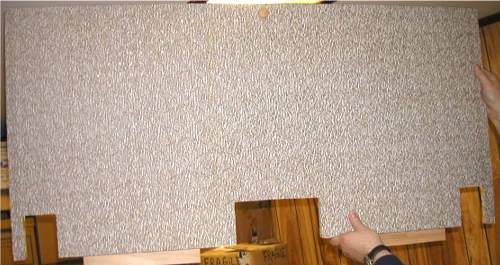
Removable rear hatch, covered in cloth from the original manufacturer

Julia: Mellotron Mark I Serial Number 124
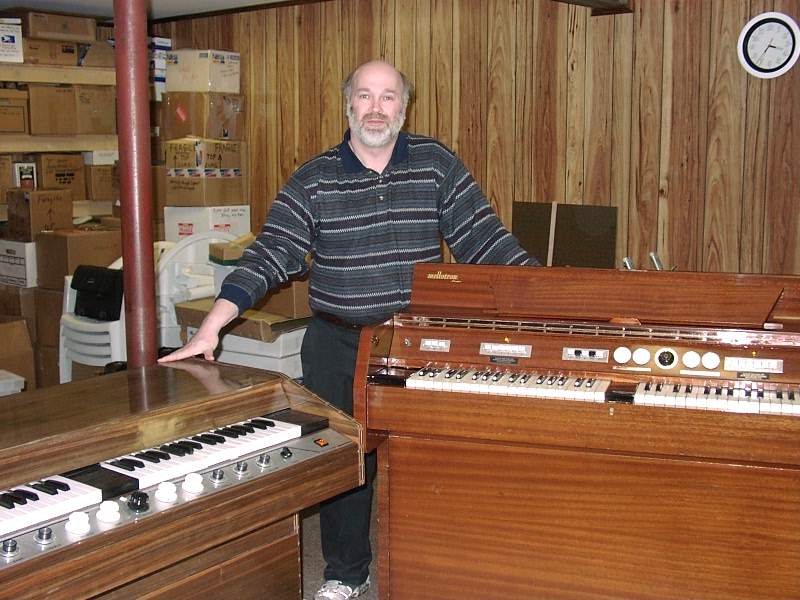
|
